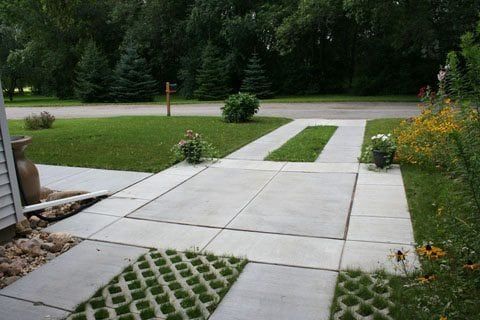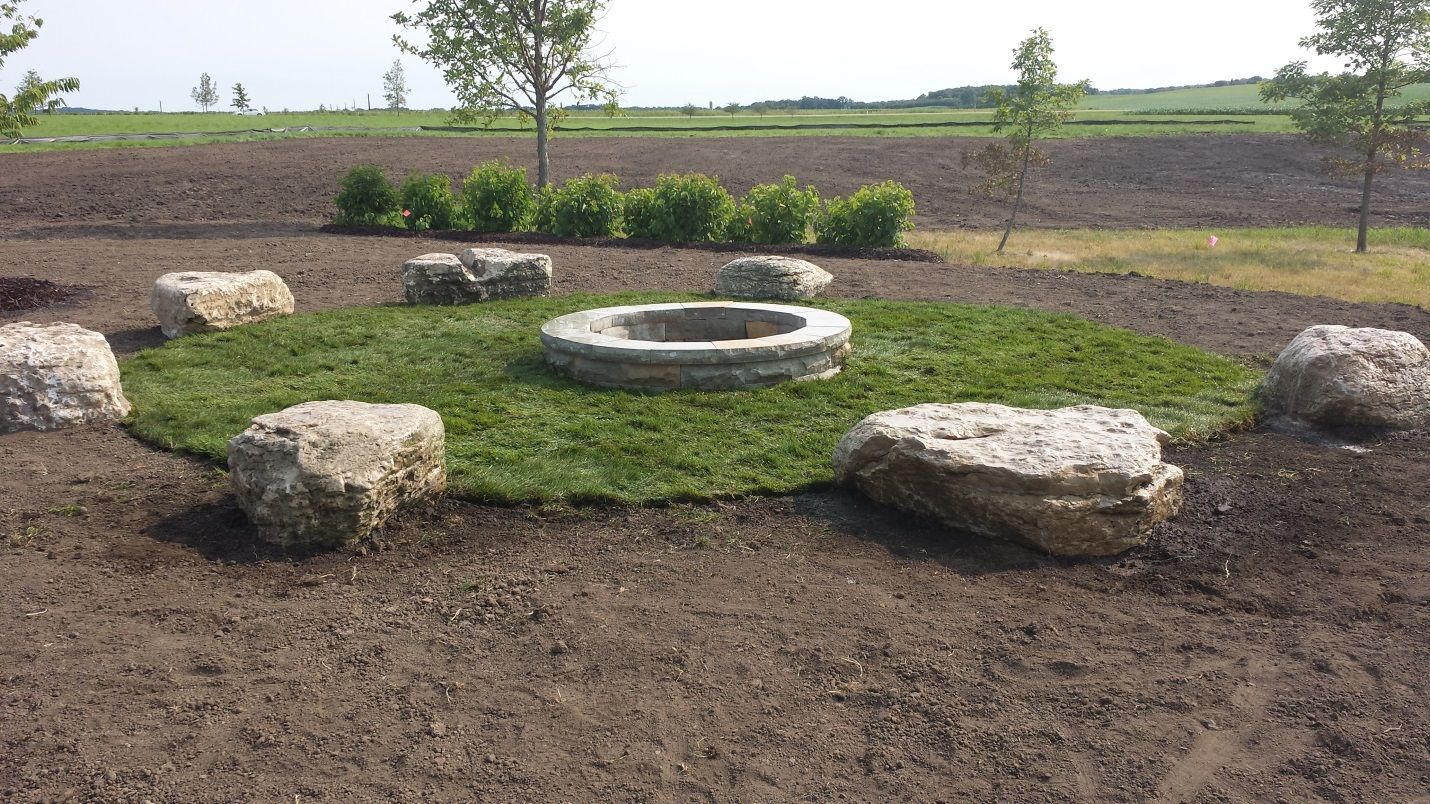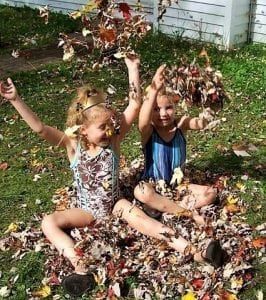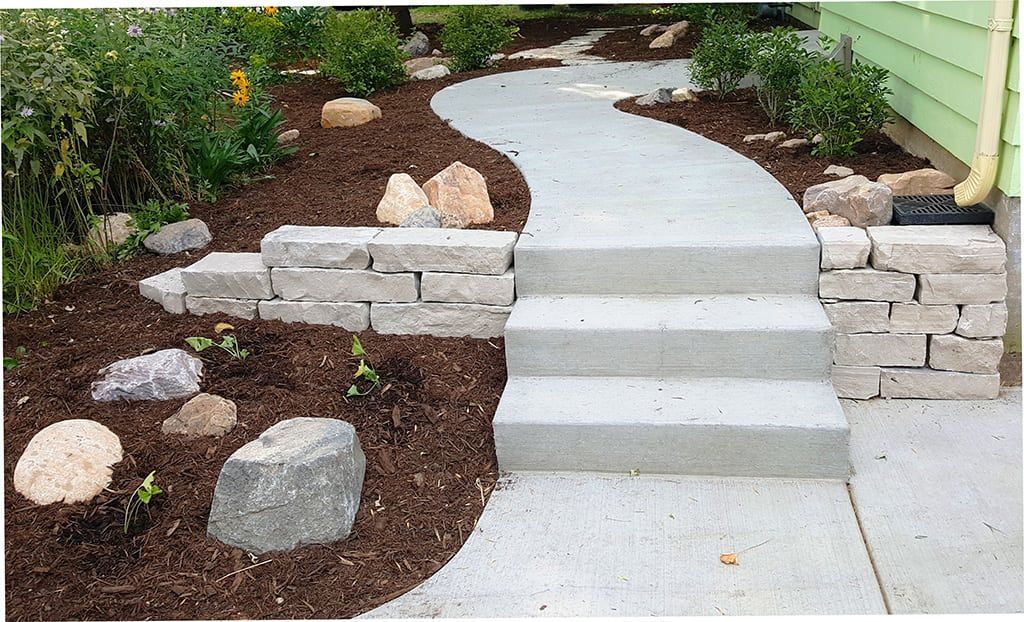NATURAL STONE HARDSCAPE & POROUS PAVEMENT
CATEGORIES

December 6, 2023
Have you ever thought about what happens to all that water when it rains? We all know that water runs downhill, but there are some other interesting consequences that aren’t so obvious. Because we have built homes, roads, sidewalks, parking lots and many other “impervious” surfaces that don’t allow stormwater to soak into the ground, there is often much more water than the limited areas can soak up (infiltrate). We are simply pushing more and more water downstream. Now, this may not seem like a large issue when we only consider an individual site, but when taken cumulatively we can see that urban and residential areas often have more impervious surface than pervious surface. Even farm fields often have drain tile to rapidly remove “excess” water downstream. Now let’s think again about what happens in a heavy rain. Excessive or poorly managed stormwater has many negative effects on our environment. Here’s how the damage shows up: When stormwater flows across compacted lawn surfaces, it picks up excess fertilizer, loose soil, and pesticides and carries them into the street or ditch where more debris, auto chemicals and other pollutants are waiting for a free ride downstream. This contaminated water races straight into engineered drainage systems, such as storm sewers, where more and more water combines from surrounding areas. This rapidly flowing (and filthy) water is dumped into creeks and streams, where it causes erosion and picks up more soil and debris. This water eventually causes flooding and degradation of lakes and other water bodies. Oftentimes after large storms, huge plumes of brown, contaminated water are readily visible in aerial photos of lakes. In fact, a large “dead zone” of nearly 6,000-8,000 square miles appears annually in the Gulf of Mexico, due to the large amounts of soil and debris carried into the Gulf by the Mississippi River. To get a bit of perspective, it’s helpful to consider how stormwater acted in the past. Historically, when it rained, most of the water soaked into the ground at or near the place where it fell. Thick native vegetation would slow the water down and the highly organic soils would readily soak up stormwater. This stormwater was purified by slowly seeping through the soil and plant roots, and it eventually recharged the water table (the source of our drinking water). No one can argue that hard surfaces like rooftops, roads and driveways aren’t incredibly important to humans, but we need to understand that because we aren’t allowing water to soak into the ground, we are causing more frequent flooding, and increased pollution, and preventing future drinking water supplies from forming. In fact, our existing drinking water wells are drying up and becoming more prone to contamination. We simply need to do a much better job of allowing water into the ground at the spot where it falls. There are some options to help accomplish this goal. Eco-friendly sustainable approaches to stormwater management are becoming more popular, as more people begin to understand the importance of treating water as a resource rather than disposing of it as a waste product. Harvesting stormwater can result in economic benefits to communities by reducing reliance on municipal water supplies. Stormwater can easily be used for irrigation, ornamental water features, and groundwater recharge with a little forethought about how to capture it. Stormwater harvesting is often as simple as diverting rainwater that runs down a residential downspout into a rain barrel , where it can be stored for use in watering your plants.

December 6, 2023
See how simple natural stones can be fashioned in a pleasing (and very democratic) seating space: Regional inspiration – 7 large natural stones (each weighs an average of 1800 pounds) are sited around a natural stone firepit. Room is left between each natural stone seat for additional seating etc. Each seating stone will comfortably seat two people so this space can handle smaller groups up to much larger sized. The seating stones were locally quarried in Waupon, WI and provided to us by our friends at Madison Block & Stone (thanks Todd!!) Hardy, native vegetation means less maintenance – Native swamp white oak and hackberry trees help provide the vertical walls that help make this council ring a true outdoor space. Walls, overhead canopy and views out make this a cozy and comfortable space. It all starts with a plan – The most important component of this outdoor seating space is to get the scale right – if the space is too big it won’t feel intimate enough and if it’s too small it will feel crammed and to tight (and maybe a little hot). Lastly, in order to render the firepit immediately useful, we opted to use turf sod around the firepit area and seed/straw for the lawn areas beyond the council ring. This was mainly done to reduce the likelihood of straw catching fire when using the firepit. In a few short months the lawn seed will germinate and fill in (and the straw will biodegrade and be gone).

December 6, 2023
Have you ever thought about what happens to all that water when it rains? We all know that water runs downhill, but there are some other interesting consequences that aren’t so obvious. Because we have built homes, roads, sidewalks, parking lots and many other “impervious” surfaces that don’t allow stormwater to soak into the ground, there is often much more water than the limited areas can soak up (infiltrate). We are simply pushing more and more water downstream. Now, this may not seem like a large issue when we only consider an individual site, but when taken cumulatively we can see that urban and residential areas often have more impervious surface than pervious surface. Even farm fields often have drain tile to rapidly remove “excess” water downstream. Now let’s think again about what happens in a heavy rain. Excessive or poorly managed stormwater has many negative effects on our environment. Here’s how the damage shows up: When stormwater flows across compacted lawn surfaces, it picks up excess fertilizer, loose soil, and pesticides and carries them into the street or ditch where more debris, auto chemicals and other pollutants are waiting for a free ride downstream. This contaminated water races straight into engineered drainage systems, such as storm sewers, where more and more water combines from surrounding areas. This rapidly flowing (and filthy) water is dumped into creeks and streams, where it causes erosion and picks up more soil and debris. This water eventually causes flooding and degradation of lakes and other water bodies. Oftentimes after large storms, huge plumes of brown, contaminated water are readily visible in aerial photos of lakes. In fact, a large “dead zone” of nearly 6,000-8,000 square miles appears annually in the Gulf of Mexico, due to the large amounts of soil and debris carried into the Gulf by the Mississippi River. To get a bit of perspective, it’s helpful to consider how stormwater acted in the past. Historically, when it rained, most of the water soaked into the ground at or near the place where it fell. Thick native vegetation would slow the water down and the highly organic soils would readily soak up stormwater. This stormwater was purified by slowly seeping through the soil and plant roots, and it eventually recharged the water table (the source of our drinking water). No one can argue that hard surfaces like rooftops, roads and driveways aren’t incredibly important to humans, but we need to understand that because we aren’t allowing water to soak into the ground, we are causing more frequent flooding, and increased pollution, and preventing future drinking water supplies from forming. In fact, our existing drinking water wells are drying up and becoming more prone to contamination. We simply need to do a much better job of allowing water into the ground at the spot where it falls. There are some options to help accomplish this goal. Eco-friendly sustainable approaches to stormwater management are becoming more popular, as more people begin to understand the importance of treating water as a resource rather than disposing of it as a waste product. Harvesting stormwater can result in economic benefits to communities by reducing reliance on municipal water supplies. Stormwater can easily be used for irrigation, ornamental water features, and groundwater recharge with a little forethought about how to capture it. Stormwater harvesting is often as simple as diverting rainwater that runs down a residential downspout into a rain barrel , where it can be stored for use in watering your plants.

December 6, 2023
See how simple natural stones can be fashioned in a pleasing (and very democratic) seating space: Regional inspiration – 7 large natural stones (each weighs an average of 1800 pounds) are sited around a natural stone firepit. Room is left between each natural stone seat for additional seating etc. Each seating stone will comfortably seat two people so this space can handle smaller groups up to much larger sized. The seating stones were locally quarried in Waupon, WI and provided to us by our friends at Madison Block & Stone (thanks Todd!!) Hardy, native vegetation means less maintenance – Native swamp white oak and hackberry trees help provide the vertical walls that help make this council ring a true outdoor space. Walls, overhead canopy and views out make this a cozy and comfortable space. It all starts with a plan – The most important component of this outdoor seating space is to get the scale right – if the space is too big it won’t feel intimate enough and if it’s too small it will feel crammed and to tight (and maybe a little hot). Lastly, in order to render the firepit immediately useful, we opted to use turf sod around the firepit area and seed/straw for the lawn areas beyond the council ring. This was mainly done to reduce the likelihood of straw catching fire when using the firepit. In a few short months the lawn seed will germinate and fill in (and the straw will biodegrade and be gone).
Eco-friendly sustainable landscaping.
Expertly designed, installed and maintained.
Tell us more about your landscape project!
Throughout our 27 year history, we have been quite different than other landscape design-build companies – we don’t limit ourselves to simply beautifying the landscape.






